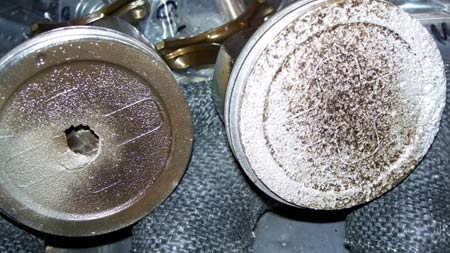Electroless nickel
The technique of electroless nickel plating has been used widely in race engines for a long time. Electroless nickel is a family of coatings rather than a single coating, and a number of electroless nickel 'composite' coatings are available. Even where the coating is a plain nickel coating rather than a composite, there are different types of coating.
Basic electroless nickel plating generally contains a high percentage of other elements, most notably phosphorous but sometimes boron. There are a range of phosphorous contents, which vary according to the requirements for corrosion resistance and as-plated hardness. Low-phosphorous coatings are quite hard as plated (>700 HV), medium-phosphorous coatings are around 500 HV as coated but may be heat-treated at a temperature of about 400 C (750 F) to increase hardness to around 1000 HV, while high-phosphorous coatings are the most resistant to corrosion when left as plated, although all compositions may be increased in hardness to above 900 HV by heat treatment.
The composite coatings are of two main types - the first has particulate 'reinforcements', the second is a multi-layer coating. The former type can incorporate a number of different particulate materials, ranging from PTFE to diamond. Electroless nickel/PTFE composites are aimed at low friction with a degree of wear resistance; electroless nickel/diamond and electroless nickel/boron nitride composite plating processes are generally aimed at wear resistance.
However, electroless nickel/diamond coatings are sometimes used in sliding contacts to increase friction and so prevent sliding. This range of properties with nickel/diamond coatings is possible owing to the size of the diamond particles in the coating. Thin coatings used in comparison with large diamond particles allow the diamond pieces to penetrate any surfaces that the coated component is trapped between. This technique is used to prevent slip in critical joints by using a coated shim. Alternatively, such coatings can be applied locally to surfaces, although masking can prove to be very expensive.

Electroless nickel/PTFE composite coatings have been applied successfully to prevent seizure in poorly lubricated piston/pin contacts, where the low friction provided by the PFTE, combined with the hardness of the nickel, has proved to be a good combination.
The multi-layer coating has a standard electroless nickel base layer, a top layer of a low-friction polymer and an intermediate layer to provide improved adhesion between the base layer and the polymer.
Perhaps one of the best-known applications of electroless nickel coatings is on pistons. In engines that are especially prone to combustion knock - that is, where very high compression ratios are used, or where the engine is supercharged or turbocharged - electroless nickel coatings can mitigate knock damage. The coating has been widely used in turbocharged rally engines for a number of years, and the main area of application is the piston crown and top land.
Other than the expense of masking, there is no practical reason why the same approach could not be followed with the cylinder head, which can also suffer severe mechanical damage due to knock. In allowing an engine to run with a certainly level of knock, or allowing the ignition to be changed to run the engine further into knock, turbocharged engines may be able to increase output. According to Towers and Hoekstra*, the nickel plating limits damage, owing to the increased strength and modulus of the coating, rather than preventing knock occurring.
* Towers, J.M., and Hoekstra, R.L., "Engine Knock, A Renewed Concern In Motorsports - A Literature Review", SAE Paper 983026
Fig. 1 - Electroless nickel plating can mitigate knock damage
Written by Wayne Ward